Lipstick plants are unique, beautiful, and surprisingly easy to care for. This detailed growing guide will show you everything you need in order to keep them thriving for many years to come.
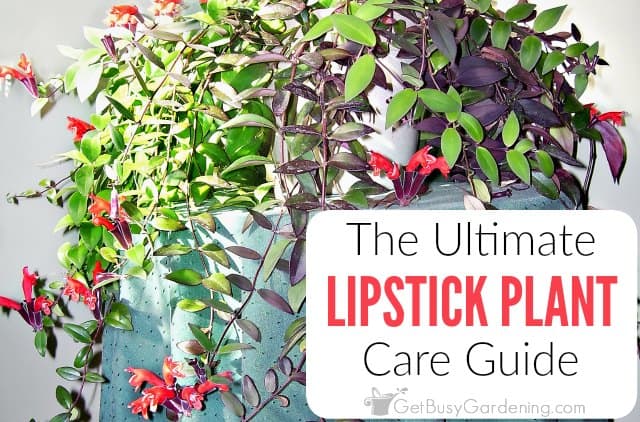
If you’re looking for a beautiful and unique houseplant to add to your collection, I highly recommend getting yourself a lipstick plant.
They are gorgeous, with thick waxy leaves and unique flowers – and lipstick plants will bloom profusely with the right care.
Plus the cascading vines look beautiful in a hanging basket, or spilling over the top of a pillar or shelf.
In this complete guide, you’ll learn all about how to care for a lipstick plant including watering, fertilizer, potting soil, lighting, troubleshooting problems, and much more!
Lipstick Plant Quick Care Overview
| Scientific name: | Aeschynanthus radicans |
| Classification: | Tropical plant |
| Common names: | Lipstick Plant, Basket Vine |
| Hardiness: | Zone 11 |
| Temperature: | 65-85°F |
| Flowers: | Red, burgundy, yellow or orange, blooms late summer-fall |
| Light: | Full to partial shade, bright light indoors |
| Water: | Keep soil moderately moist, do not overwater |
| Humidity: | High |
| Fertilizer: | Flowering plant food spring-summer |
| Soil: | Fast-draining soil |
| Common pests: | Aphids, spider mites, mealybugs |
What Is A Lipstick Plant?
A lipstick plant (Aeschynanthus radicans), also known as basket vine, is an unusual flowering houseplant that is native to the tropical regions of Southeast Asia.
It gets the common name from the blooms, which are very unique. As they open, they look like lipstick coming out of its tube.
The flowers form at the ends of long trailing stems, which can reach lengths of 2′ or more. Though most commonly grown in pots or the ground, they can be epiphytes in their native habitat.
Common Lipstick Plant Varieties
There are lots of different types of lipstick plant varieties out there, so you can add several to your collection. Here are a few of the most common ones you might find…
- Black Pagoda – This unique hybrid has mottled foliage and bright yellow-orange flowers that taper to red on the tips.
- Curly leaf (Aeschynanthus radicans ‘Curly’, aka “Curly Q”) – The leaves on this variety curve upward, giving them a slightly wavy look.
- Mona Lisa (Aeschynanthus radicans ‘Mona Lisa’) – This type has darker green foliage with smaller leaves, and gets redish-orange flowers, a really lovely contrast.
- Rasta (Aeschynanthus ‘Rasta’, aka “twisted lipstick plant”) – A wonderful cultivar that has eye-catching twisted leaves, making it beautiful even when it’s not flowering.
- Variegated – If you’re really lucky, you’ll be able to find one of the rare variegated hybrids, which can have golden-green or white and green leaves.
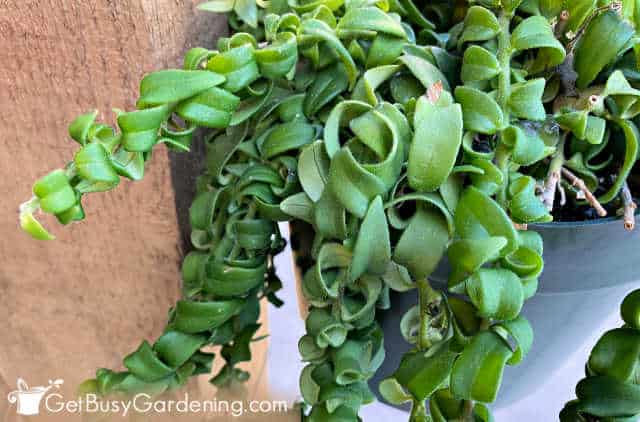
Flowers
The flowers are what give the lipstick plant its common name. The reason? Well, when they open, they look like tubes of lipstick.
Depending on the specific variety you have, the colors can range from burgundy to yellow or orange, with bright red being the most common.
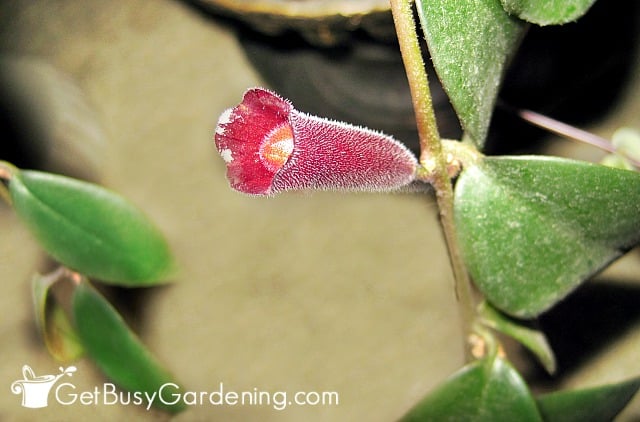
How To Grow Lipstick Plants
Before we talk about the specifics of lipstick plant care, it’s important to understand where to grow them. Choosing the right location is important for their longevity.
Hardiness
Unfortunately, lipstick plants are not hardy at all. They can only survive as perennials in zone 11 where it stays warm year-round.
If you live anywhere else, then you must keep them as houseplants or bring them indoors before it drops below 60°F.
Where To Grow
As long as it stays warm enough, lipstick plants can grow equally well outdoors as they can indoors.
Thankfully, they do great in pots with adequate drainage, so they’re easy to move.
Indoors place them in a spot where they’ll get bright filtered sunlight. Outdoors, keep them in the full to partial shade location.

Lipstick Plant Care & Growing Instructions
Now that you know where to grow them, let’s dive into all the details about how to care for a lipstick plant. As long as you follow these basic requirements, yours will thrive for years to come.
Watering A Lipstick Plant
Lipstick plants prefer to be kept on the dry side, but never left totally dry. They’re drought tolerant, and do not like being overwatered.
However, if they become severely dehydrated, the leaves will start to turn brown and drop off.
Ideally, the top few inches should feel dry, and the rootball should stay lightly moist, but never wet or completely dried out.
Be certain to always check the moisture level before giving them more, to avoid overwatering. If you struggle with this, I highly recommend you get an inexpensive soil moisture gauge to help you out.
Humidity
A humidity environment is also very important, so a bathroom or kitchen would make a great home. They like it to stay around 50-60%, and you can use a monitor to track it.
Otherwise, you can mist the leaves regularly as part of your lipstick plant care routine, run a humidifier near it, or keep it on a pebble tray.
Light Requirements
The lipstick plant prefers bright, indirect sun, and will bloom its best when given plenty of light. Mine thrives near a south facing window in my living room, where it gets filtered sunlight all year long.
When they don’t get enough light, they won’t bloom. If you don’t have a room in your home that gets indirect, bright light, then you can add a grow light to supplement.
If you put yours outdoors during the summer, be sure to keep it out of the direct sun. A partial to full shade location is the best choice. Direct sunlight is too intense, and it can burn the foliage.
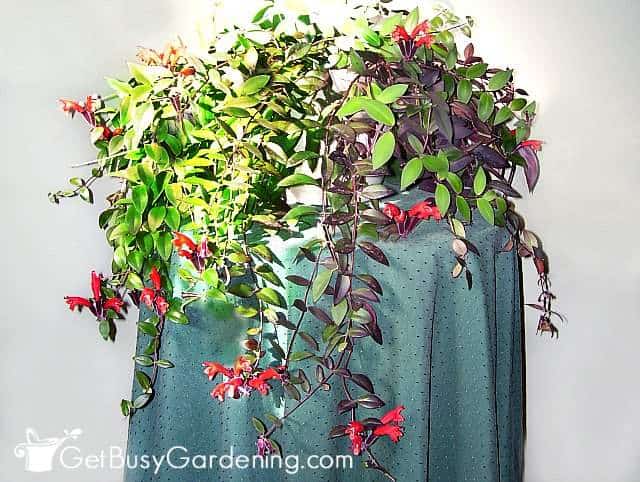
Temperature
The ideal temperature range for lipstick plants is between 65-85°F. Anything outside of that range will start to impact their health.
They can withstand temps as low as 40°F in short bursts. But long periods of cold exposure will cause them to stop growing and begin dropping their leaves. Freezing weather will quickly kill them.
While they can handle the heat much little better, they may begin to suffer if it gets extremely hot (above 100°F). In that case, keep them in the full shade, and increase the humidity level.
Best Potting Soil
Lipstick plants don’t require any special soil, and will usually grow just fine in general potting mix.
But if you tend to overwater, I recommend amending your potting soil with coarse sand and perlite or pumice to add extra drainage.
Otherwise, it’s best to use a commercial medium that’s fast draining, or an African violet mix.
Fertilizer For Lipstick Plants
To get the best blooms, fertilize in the spring through summer as part of your regular lipstick plant care routine.
I recommend using organic option rather than chemical ones because they work better, and there’s less of a chance of burning the sensitive roots.
A general purpose option or compost tea would work great. You could also use slow-release granules if you prefer, or one for flowering plants.
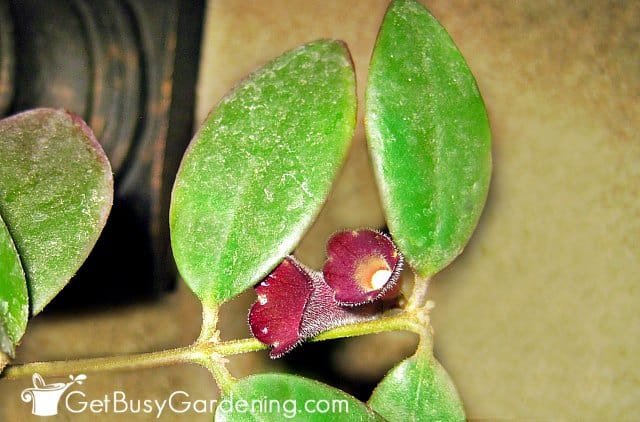
Common Lipstick Plant Pests
Healthy, well cared for lipstick plants don’t usually have problems with pests. But sometimes aphids, spider mites, or mealybugs can become a problem.
If you find any bugs, be sure to treat for them immediately. I recommend using either neem oil, an organic insecticidal soap, or a combo of both.
Or make your own spray by mixing 1 tsp mild liquid soap per 1 liter of water. You can also spot-treat insects by dabbing them with a cotton swab dipped in rubbing alcohol.
Repotting Tips
They will bloom better when they’re root-bound, so don’t repot your lipstick plant until it’s absolutely necessary. There’s no set schedule for how often to do it, that depends on how fast it grows.
You’ll know it’s time when the roots have completely filled the pot and are coming out the drainage holes. When it’s time, only go up one pot size for the best results.
How To Prune A Lipstick Plant
Pruning lipstick plants will encourage them to grow fuller, rather than longer vines, but it’s usually not a necessary part of their care.
If yours is looking untidy, or not very full, then you can trim them to the desired length. The best time to do it is right after it’s done blooming, or any time in the spring through early summer.
Be sure to use a sharp pair of precision pruners, or use bonsai shears to prune the delicate vines.
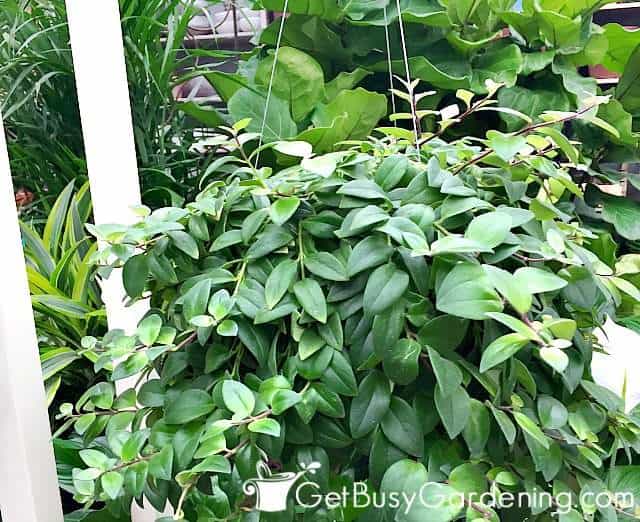
Aeschynanthus Lipstick Plant Propagation Tips
Propagating lipstick plants is actually really easy by taking stem cuttings, or by division. They can also be multiplied by seeds, but this is the slowest option.
Stem cuttings can easily be rooted using a propagation chamber. Be sure to dip the cut ends in rooting hormone first, this will help to speed things up.
Learn all about how to propagate your lipstick plant step by step here.
Troubleshooting Lipstick Plant Care Problems
For the most part, lipstick plants are easy to care for. But through the years, you’ll likely run into some common problems. Use my tips below to get yours back to health.
Lipstick Plant Dropping Leaves
The most common cause of lipstick plant leaves falling off is improper watering, usually too much. Check the soil by sticking your finger one inch down to make sure it’s dry before giving it more.
If it’s wet, then allow it to dry out a bit before watering it again. I recommend getting a soil moisture gauge to help you get it just right.
However, leaf drop could also be caused by extreme temperatures, especially if it gets down below 60°F.
Flowers Or Buds Dropping Off
Bud or flower drop is also usually caused by improper watering, either too much or too little.
It can also be caused by sudden shifts in temperature, or change of environment (like if you recently moved the plant to a new location).
Avoid moving the plant while it’s setting flower buds, and keep it away from heating and cooling vents, as well as fireplaces and space heaters.
Leaves Turning Yellow On Lipstick Plant
If the leaves on your lipstick plant are turning yellow, that means it either needs more water, more light, or maybe both.
Always check the soil moisture level, and if it’s wet then don’t give it more water. If it is in a low light location, move it closer to a sunny window or add a grow light to supplement.
Lipstick Plant Won’t Bloom
If your lipstick plant won’t bloom, then it’s not getting enough light, or needs to be fertilized.
Move it to a brighter spot, or add a grow light. If you’ve never fed it before, then try giving it a weak dose of liquid fertilizer in the spring through summer to give it a boost.
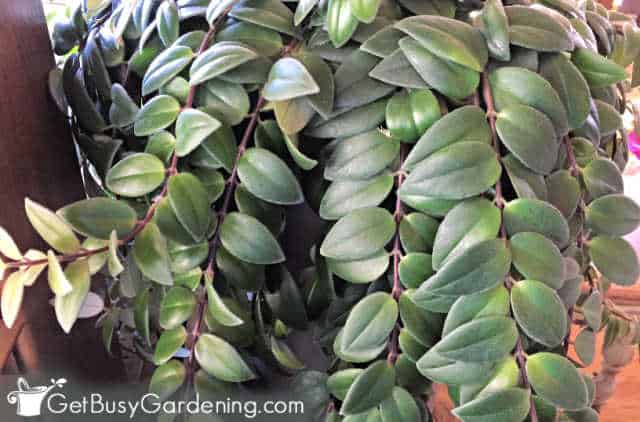
FAQs
In this section I’ll answer some of the most commonly asked questions about Aeschynanthus radicans. If you can’t find your answer here, ask it in the comment section below.
When do lipstick plants bloom?
Lipstick plants generally bloom during the late summer and early fall, but can flower anytime throughout the year. Mine continues to bloom on and off all winter, which is such a treat.
Are lipstick plants toxic?
No. Lipstick plants are not toxic to pets or humans, so you’re safe to grow them around cats, dogs, and the kiddos.
Are lipstick plants easy to grow?
Yes, lipstick plants are easy to grow once you know how to provide what they need. The keys to success are to avoid overwatering, give them plenty of indirect sunlight, and high humidity.
Where do I put my lipstick plant?
The best spot to put your lipstick plant is in a bright location where it will get plenty of humidity. Indoors, place it near a sunny window. Outdoors, put it in a full to partial shade location.
Is a lipstick plant a succulent?
No, a lipstick plant is not a succulent. Though it is drought tolerant and has thick leaves, it’s technically a tropical plant.
How fast do lipstick plants grow?
Lipstick plants can grow fairly fast with the proper care. They can put on several inches per year, but are usually slower indoors than outside.
Lipstick plants are fun and easy to care for. Now that you know all about how to grow them, you’ll have great success. Simply follow the instructions in this detailed guide for the best results.
If you want to learn all there is to know about maintaining healthy indoor plants, then you need my Houseplant Care eBook. It will show you everything you need to know about how to keep every plant in your home thriving. Download your copy now!
More Houseplant Care Guides
- How To Care For Goldfish Plant (Nematanthus gregarius)
- How To Care For An Orchid Plant
- How To Care For Plumeria Plants (Hawaiian Frangipani)
- How To Care For An Amaryllis
- How To Care For A Peace Lily Plant
- How To Care For String Of Hearts (Ceropegia woodii)
Share your lipstick plant care tips in the comments section below.
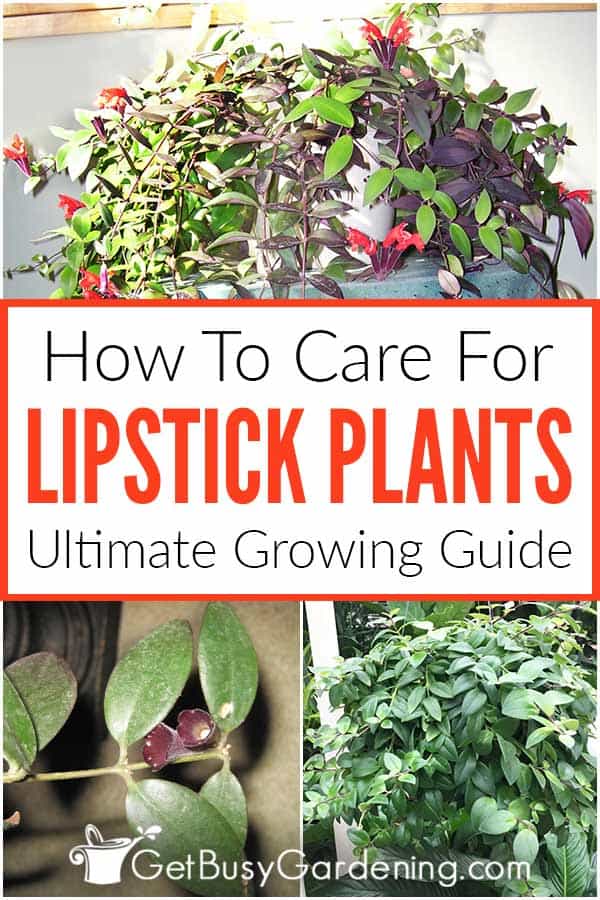
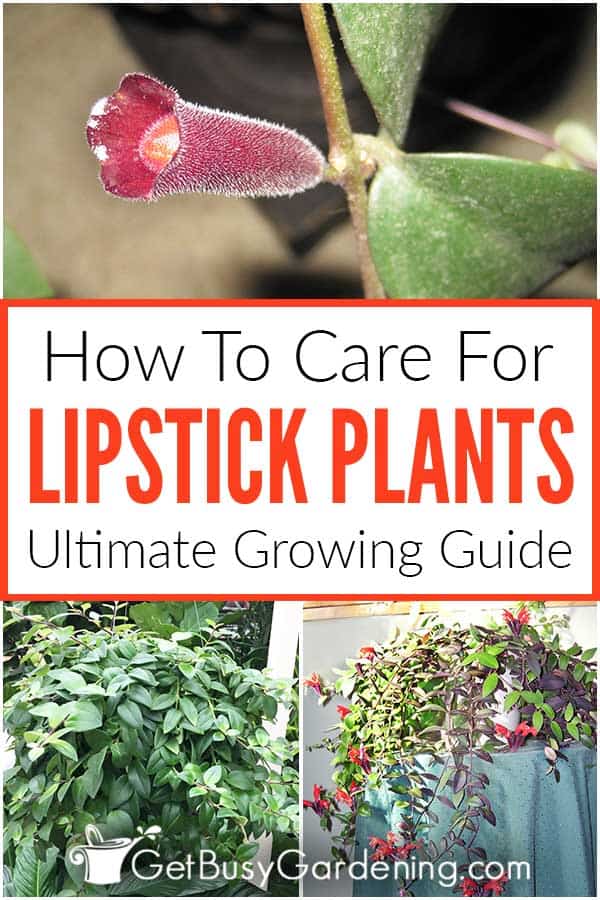
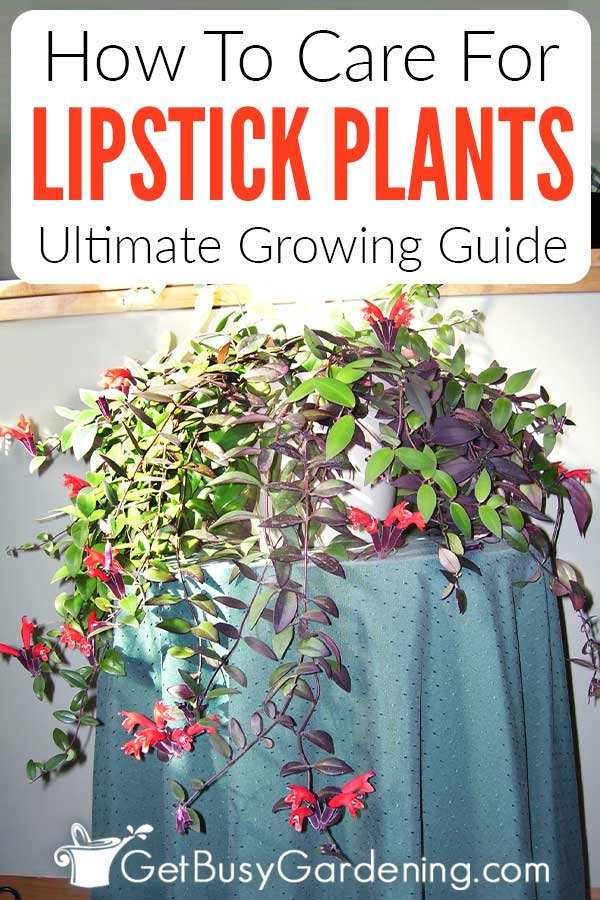



SydCw says
When do these need solid refreshing or potting on? Oddly enough mine seems to thrive on neglect. I have mine hanging in a direct sun (uk) South facing window in the guest bathroom that gets very warm in the summer months and my plant has a good amount of flowers on it continuously since purchasing it for the last 2 and half years all year round, which is nice for a spash of colour especially in winter. I never move it from the window even winter and have only fertilised it twice with slow release fertiliser and water once a week or fortnightly in the summer months down to once every 3 to 4 weeks in the winter months. It has survived a visiting relation leaving the bathroom window open for two days in the middle of December and I get the occasional leaf fall but only a few , if that happens I just turn the hanging pot that it is in around and the thing is as happy as Larry. I would like to move it, but I know as soon as I do it will probably die on me, So I will try propergate it on this advice.
Amy Andrychowicz says
Sounds like it loves the spot you have it in, so I would just leave it there. Lipstick plants like to be pot-bound, and bloom better when they are. So only repot it once it has completely outgrown its current container, and go up just 1-2 pot sizes when you do. The best time to do it is in the spring or early summer.
Marsha Simpson says
I just had my seed pod open and drop seeds in the bottom of a bag . Now what do I do with them?
Thanks
Amy Andrychowicz says
Oh how exciting! Like most tropical plants, lipstick plant seeds don’t remain viable for very long. So it’s best to plant them right away. They are tiny, so sprinkle them over the soil and barely cover them. Then keep the soil evenly moist and warm until the seedlings start to emerge. Good luck!
Shay Vhal says
My daughter’s lipstick plants stem are turning brown and then the green leaves are falling off. What is wrong with it.
Amy Andrychowicz says
When the leaves drop off a lipstick plant, it’s almost always due to improper watering. They like the soil to dry slightly between waterings (but never be bone dry) in the winter, and then be consistently moist (be never wet or soggy) in the summer. So the first thing to do is check the soil by sticking your finger at least an inch down. If it feels wet then let it dry more, if it’s dry then give it a drink, and water a bit more often. They also like a lot of humidity, so make sure it’s in a humid location, or you can try misting it regularly.
Cynthia Shewchuk says
Hello, hope you can figure this one out !
My lipstick plant has been dropping some green leaves. Although it flowers profusely which is refreshing in the winter, I notice that some of the green leaves are wrinkled even though the soil is moist. Any idea what is the reason ? I’m stumped ! I have had the plant in the same location for about 2 yrs. But bcuz some leaves have dropped, it is getting some spindley areas on the plant.
Amy Andrychowicz says
Wrinkly or dropping leaves on a lipstick plant are both signs of improper watering (either too much or too little). If the soil is moist, then I recommend allowing it to dry out more between waterings. They don’t need as much water during the winter as they do in the summer. Also, check the base to make sure there’s no sign of rot. In extreme cases, they can slowly die from the base up after being overwatered for a period of time.
Sarah B says
Just curious at the growth rate of these plants! I just got a Black Pagoda and am hanging it over my kitchen sink in the window, but might have to move it if it starts to grow too fast.
Amy Andrychowicz says
Lipstick plants can grow fairly fast in the perfect conditions. But indoors, they are usually slower. If the vines get too long for the spot you have it, you can always trim the back to keep them the size you want rather than moving it. Enjoy!
georgie says
My lipstick plant keeps getting dark leaves. It came by mail 3 weeks ago Im giving it light humidity and moisture meter says moist Im at loss I dont know how to get it to perk up. There is no bug mold its just not happy and I do not know what to do.
Amy Andrychowicz says
Dark leaves can mean a few things. If they are turning more of a black color than brown, then it’s likely due to overwatering. Lipstick plants don’t need as much water during the winter as they do in the summer. So it’s better to let the soil dry slightly between waterings, rather than keeping it moist at all times. However, black leaves on a lipstick plant could also be caused by exposure to freezing temps. So, if you live somewhere cold, then check to make sure it’s not touching the window, or getting blasted with cold air near an exterior door. On the other hand, dry brown leaves could be caused by chemicals in the water (softener salt, chlorine, etc), or over fertilizing. Use filtered or distilled water, switch to an organic fertilizer (rather than a synthetic one), and don’t feed them during the winter. Good luck!
MEM says
i too am in zone 4, the UP of Michigan, and my Hummingbirds love the lipstick plants…
This year I am bringing them indoors, I divided the plant into 2 and gave it fresh dirt and new pots
before I brought them in. I have 1 room with East exposure that is available for the newly divided plants, and hope that works
When I bought my plants they were the only 2 left at the store and I had to fight a lady for them so I want to make sure I have a couple with Spring coming up..
If I have any questions, for sure I will come back here to read this article again and again…
Thank you so much, wish this plant was easier to come by in the garden centers
Amy Andrychowicz says
You’re welcome! I never understood why it’s so hard to find lipstick plants at the garden centers either. It’s such a lovely, low maintenance plant. Everybody should have one! Enjoy yours indoors this winter, hope they will all thrive for you! 🙂